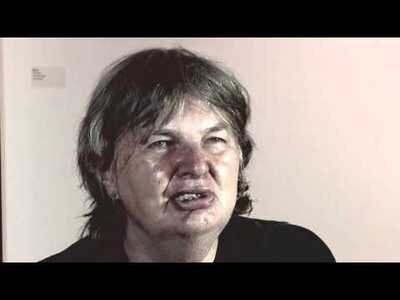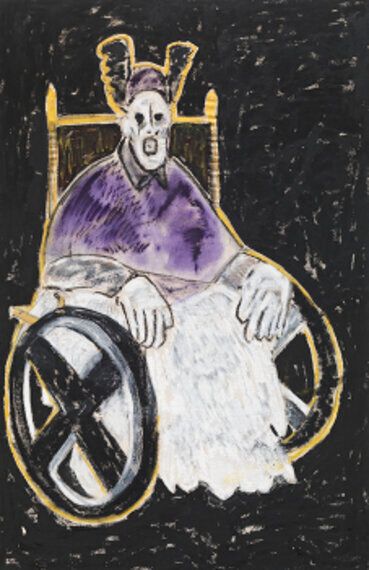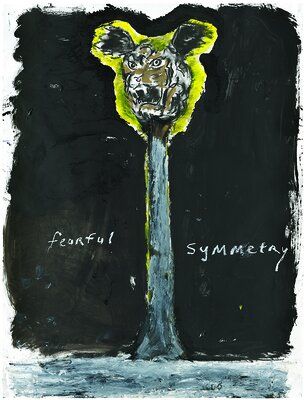
I met artist John Scott back in Windsor in the late 60s, long before he started painting bunny ears on boxer Mike Tyson and a sci-fi wheelchair for a long-forgotten pope! It was my first year being on-air at the Windsor U radio station and it was an era of profound change in Canada's Motor City.
Back then Scott was a young street artist. He was also a factory worker (he had dropped out of school before he finished Grade 10) and a union activist.
It was a good time and a good place for him to be. Anyone young and living in Windsor in that decade, John Scott included, was politically aware and ready to take to the streets to support the cause of the week.
He had a ringside seat for the burning of an American city during the Detroit Riots. There were the anti-nuke protests that brought us all out to shut down the Ambassador Bridge -- industry's causeway into the U.S. The anti-war movement was in overdrive, fuelled by an army of American draft dodgers who sought asylum. It was interesting times that had a strong impact on all of us -- none more so than John Scott.
His art was born out of the anti-war movement. Scott was one of this country's first anti-establishment painters who was impacted by the Cold War and the raging war in Vietnam. He wasn't supported in his art by government grants and largess from deep gallery pockets; instead, he got by working in a chemical factory by day and painting his black and white cartoonish canvasses at night.
In the 70s Scott was in Toronto attending what is now the Ontario College of Art (where he currently works). By the 80s his art had been elevated from the street level to the rarefied world of public galleries and high-end galleries. He earned a Governor General's Award in 2000, and many of his large, science-fiction driven paintings were being sold before the paint even dried on the canvas.
"Scott's bold and rough graphic drawings are characteristically crude, often made with the cheapest materials at hand. One of his working methods was to repeatedly soak paper in solvent and develop an image by grinding-in dark pigments, thick black paint, graphite and charcoal," says the Federal National Gallery.
Scott's work is part of the National Gallery's permanent collection. "Scott has depicted dark warplanes hovering over destroyed landscapes devoid of human presence. He has also drawn rabbit-like figures to stand in for the anxiety-ridden human being, the harassed victim of the technological threat and militaristic oppression. Heavy dark lines record an impending sense of tragedy and terror."
Health issues and substance abuse problems kept him out of the public eye early in the century. Scott has overcome those issues and is now seeing his work exhibited at public galleries across across North America.
I met up with John Scott last fall at a downtown Toronto gallery as he prepared for a comeback exhibition. It was a triumph success where some of the city's top rock 'n' rollers snapped up his $40,000 paintings.

Innocent Pope by John Scott
Forty years almost to the day I first interviewed him, Scott talked on camera to me about the influence Windsor has had on his art. He also explained to me how his vision of Pope Innocent X is deeply entwined with Doctor X of the X-Men comics and Irish painter Francis Bacon's paintings of the pope.
Scott talked to me about his paintings of Mike Tyson, complete with bunny ears and the pope in his X-Men wheelchair on YouTube. Filmed and produced by Canada Art Channel's George Socka, the two Toronto interviews can be found here and here.
John Scott's art is currently on display in a touring exhibition that has crossed Canada and the United States. The first half of the show just closed at the McMaster University Gallery in Hamilton. Part Two opened earlier this week across town at the Art Gallery of Hamilton.
The exhibition, curated by Faulconer Gallery at Grinnell College, Iowa, has its official launch on February 20 in downtown Hamilton, it runs until May 15, 2016.
Fearful Symmetry includes 28 works on paper in a vast installation in the AGH's largest rooms reserved for contemporary art exhibitions.

The AGH describe the work of Scott as being driven by his "imagination (that) has been fed by science fiction, the Space Age and Motor City (Windsor) manufacturing might and blight. Sympathy for the worker as a human tool in the global industrial complex pervades what some have called his apocalyptic vision.
Follow HuffPost Canada Blogs on Facebook
MORE ON HUFFPOST:
